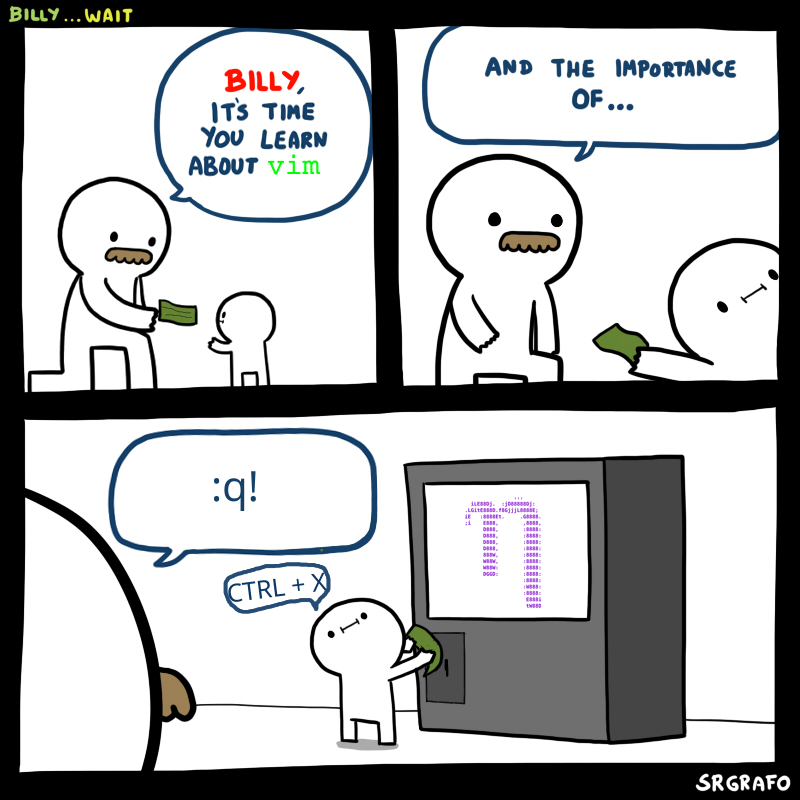i do all my vimming in visual studio code
https://marketplace.visualstudio.com/items?itemName=vscodevim.vim

Emacs users be like
Sorry for living under a rock, but what is vim?
It’s a text editor. It all began with the ed editor, which is very simple and does one thing, it edits files. Then someone extended it into the ex editor. Then someone added a new feature: being able to visually see the file you’re editing, which became vi, the visual editor. Then someone improved that, into vim. What began as an editor where you needed to be fluent in regular expressions but otherwise was simple, is now a very complex editor, moving the functionality of the old UNIX tools into the editor itself.
Thank you for explaining!
It’s also available on nearly every unix-like machine since the 70s. So, super useful to know how to use. I personally also like (neo)vim as an IDE and its optional regex functionality because that allows once to efficiently edit massive files with minimal effort.
At least it’s better than
ed.?
I kakoune instead.
fellow noun->verb user :)
helix superiority however.
How do you like it? I tried it a few years ago, but my vim muscular memory made it feel as uncomfortable as learning vim for the first time.
I’m very happy. I had the same early experience as you, but I kept with it. I’ve been using it several years now. When I’m forced back to vim, my fingers remember just enough, but I have to undo pretty often.
Tried neovim a couple of times. Stopped after 10 or 15 mins. Anyone has useful tips to get used to vim/neovim?
There are plenty of cheat sheets online. The main thing is understanding that there are different modes, knowing what they do, and how to switch between them and issue commands.
deleted by creator
I became a fan after I got used to nice color schemes, buffers/tabs, horizontal/vertical splitting, file browsing with NERDTree and highlighting changes with GITGutter.
You ask for tips? Add VIM commands you use regularly (like paste mode toggle for example) to a keyboard shortcut (like leader key + p) in your .vimrc settings file. It increases working speed.
Also add some plugins, they are fun and add useful functions from other editors like Sublime (ctrl-p, vim-multiple-cursors).Go through the tutorial. It is quite good and teaches things incrementally with real world examples. Just run vimtutor to start.
But why learn all that? Nano user here.
Depends how much time you spend in a text editor. If it is just for a few config edits and stuff, honestly there is little reason to learn. The real benefit is if you spend a lot of time editing text due to the time saved using more powerful commands. There is the additional benefit that vi/vim is installed on practically any Linux box, so you will almost always have a familiar editor to hand in an unfamiliar environment.
Just get used to
- using movement (hjkl),
- going between insert and normal modes (i and esc),
- undoing (u from normal mode),
- and saving (:w and :wq).
Don’t try to do it all at first, just get comfortable with the essentials. You can even just stay in insert mode (the only mode in most editors) at first.
Keep a vim basics cheat sheet handy for a couple weeks as you’re building in muscle memory, then slowly work in more advanced techniques and combinations.
It doesn’t take long before you start having a lot of fun just manipulating text.
PS here’s a decently basic cheat sheet I found:

I always forget about :wq, mainly because escing out of interactive mode and hitting ZZ is so much quicker.
unrepentant nano gang rise up

I’m always vimming!
Not because I want to though. It’s because I don’t know how to stop…
Can’t stop won’t stop
We’re you referencing this by chance?
The first time I used VI I typed a few characters, then hit backspace to delete some characters. Backspace doesn’t delete characters. I closed VI and never opened it again.
You need to type
ifirst to enter insert mode.Now I can’t exit HELPPP
^C^C
And you weren’t curious about how it worked? Not at all?
A million better alternatives exist. I was curious about them.
But how did you close it?
Carpenter’s axe to the utility line outside my house
Yeah yeah, brag about being able to close VI the first time of use…
well, I am using vim, but I don’t know how to use vim.
Am I vimming?
Yes, you vom.
They vom it.
If you dont know how to exit vim, then yes you are…
Escape,
:wq!Escape enters command mode
: prompts the command
W = write
Q = quit
! forces it
:what^C^C^C^Z^Z^C^ESCFFUUUUUUUUUU...I remember that experience first time and how I had to kill the process from another shell :)
This was before the internet so couldn’t exactly google it either.
Fun times. But I figured it out by reading the man page.
hides in Kate and a Codium-based IDE

















